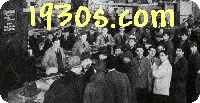This page contains Frequently Asked Questions (FAQ) and answers regarding food, general goods
and prices of items (including food)
in the 1930s time period. The questions are organized by sub-category as best as possible.
Q: What types of food would eat in a typical day?
A: I can only tell you
what type of diet we had at that time. As these years were
economically tough I am afraid the diet was not too varied
but my folks did the best they could.
Breakfast: Hot Oatmeal milk and sugar and perhaps a glass
of milk. Perhaps hot porridge.
Lunch: Home Made Soup with Bread or Sandwich of some
sort Possibly with peanut butter or banana.
Supper: We ate a lot of hamburg as it was the cheapest meat.
Potato and perhaps cabbage (or some kind of vegetable).
Possibly a repeat of lunch if there
was enough left over from lunch.
Also ate a lot of stews. Hamburg was the meat mainstay -
cooked many ways in varied dishes such as shepherds pie.
We rarely had dessert except on special occasions.
There was six kids in our family and believe me it was no easy
task feeding kids during these years. People that had more
money than us probably had a little better diet.
There was no eating in restaurants or treats at the candy store.
Q: Can you describe sharecropping?
A: Sharecropping was a contract between
land owners and tenants. Tenants would sow seed
and nuture crops. The tenant would then get a portion
of the profit from the sale of the crops.
They did use reapers, binders, balers and tractors.
but ofttimes men would use a scythe to cut down hay
and handpick other crops such as corn.
General Goods
Prices
Q: What were the prices of food items?
A: Food prices in the 30's were pretty low as these
were pretty lean years after the Stock Market
Crash of 29. Eating out was not a common
thing for the working class. However, I will
attempt to give you some prices to the best
of my recollection.
Coffee 5 or 10 cents a cup . Donuts 5 cents.
Hamburger 15 cents. Fries 10 cents. Hot
Dog 10 cents. Roast Beef Dinner $2.00
Ice Cream Cones 5 cents. Soup 10 cents
a bowl. Assorted sandwiches 15 cents.
Cokes 5 cents.
Bread 10 cents. Butter 29 cents. Milk 10-15 cents qt.
I do not remember milk by the gallon. Our milk was delivered
by a milkman driving a horse and wagon. They were in quart
bottles and was pasteurized so all the cream was on the top.
Hamburg 15 cents lb. Potatoes 20 cents a peck.
Soup bones free - and we sure made a lot of
soup in those days.
These were economically tough years and you
just had to be a good shopper for groceries and
any other needs.
I must confess that we were a pretty poor
family in the 30's and eating out for me was
non existent.
More price info:
Colored Thread - 10cents a spool
Coal Oil - 25 cents a gallon
Light Bulbs - 3 for 25 cents
Shoestrings - 5 cents a pair
Hair Dressing - 20 cents a bottle
Balloons - 1 cent each
Flower Seeds - 3 packs for 10 cents
Flour - 50 pounds for $3.00
Canned Goods (variety) - 10 cents
All of the above are approximates
Q: Can you tell me some prices of goods in the 1930s?
A: I have seen gas stoves for
as low as $50.00 Price of gas was about 7 - 10
cents a gallon.
My mom and dad
rented a two story home for $8.00 a month - and even
that was a struggle to get together. Bread would sell
for 10cents a loaf. $2000 to $3000 would buy an
average house . Cars from $900 to $1400. Shoes
$8.
Some other prices: a fountain pen would cost 50 cents plus ink.
A dining room set would cost $150.00
Hard cover books would run about $2.00 but we mostly used the
library because it was free reading.
You could buy a writing tablet for 25 cents.
Shoes for women would run between $5.00 and $9.00.
Shoes for men would be around $10.00.
Pictures to hang on the wall would cost somewhere around $5.00 and up.
A man's suit could be bought for $20.00 and up.
A woman's dress could be obtained for $7.00 to $10.00.
Washing machines were not available and my mother washed all
our clothes in a wash tub or laundry tub. She had a scrub board
and believe me it was darn hard work. In the 40s we acquired one
which cost $125. An iron would cost about $10.

